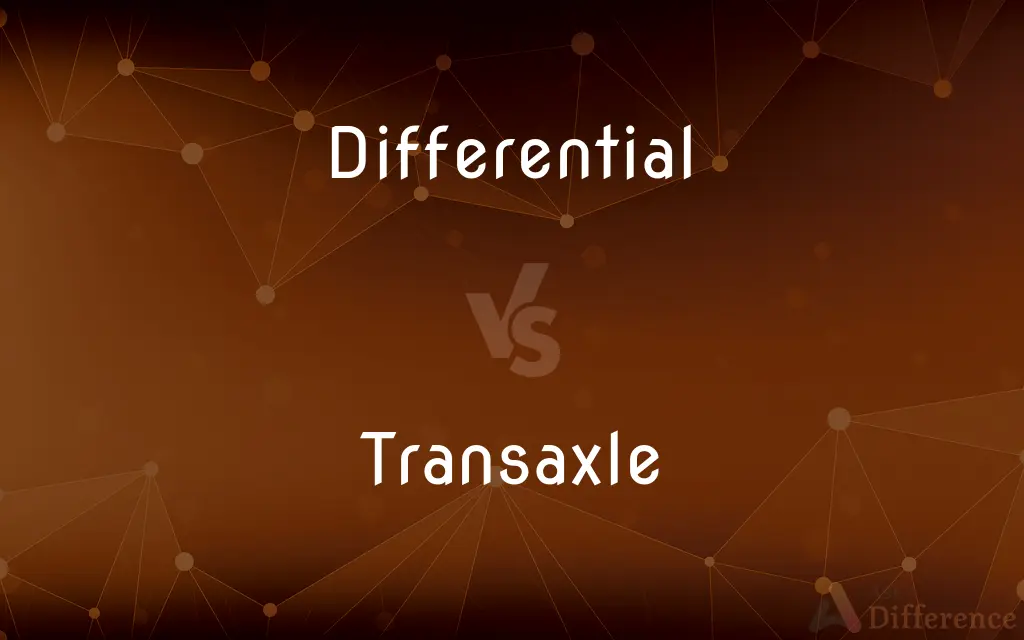Differential vs. Transaxle — What's the Difference?
Edited by Tayyaba Rehman — By Urooj Arif — Updated on April 9, 2024
A differential is a set of gears allowing wheels to rotate at different speeds, essential for turning. A transaxle combines transmission, differential, and axle into a single unit, typically found in front-wheel drive vehicles.

Difference Between Differential and Transaxle
Table of Contents
ADVERTISEMENT
Key Differences
A differential is a mechanical device specifically designed to allow two connected wheels to spin at different speeds, a necessity for smooth and efficient vehicle turns. This component is crucial for maintaining traction and preventing tire wear during turns, as the wheel on the outside of the turn needs to rotate faster than the inside wheel. On the other hand, a transaxle is a more complex assembly that integrates the functions of the transmission, differential, and sometimes even the axle into a single compact unit. This integration is particularly advantageous in front-wheel drive vehicles, where space constraints demand efficient use of the available area.
The primary function of the differential is to split the engine torque two ways, allowing each output to spin at a different speed. This function is vital for rear-wheel and all-wheel drive vehicles, where the differential is a separate component from the transmission. Conversely, the transaxle's design serves multiple functions, including not just differential gearing but also the gear changing functions of a transmission. This multi-functionality allows for significant space and weight savings in the vehicle design, contributing to better fuel efficiency and improved handling.
Differentials are found in nearly all types of vehicles, irrespective of whether they are front-wheel drive, rear-wheel drive, or all-wheel drive, due to their fundamental role in vehicle dynamics. Transaxles, however, are specifically utilized in vehicles where packaging efficiency and weight distribution require the integration of the vehicle's transmission and driving axle components. This includes most front-wheel drive cars and some rear-engine, rear-wheel drive vehicles.
The complexity of maintenance and repair differs between the two. Differentials, being a single-function component, tend to be simpler to service and repair compared to transaxles, which require more comprehensive knowledge due to their integrated nature. The failure of a transaxle can impact the vehicle’s ability to shift gears in addition to affecting the differential function, necessitating more extensive repairs.
Both the differential and transaxle are essential for modern vehicle design but serve different purposes and configurations. The differential is focused solely on allowing wheels to rotate at different speeds, while the transaxle is a multifaceted component that supports the vehicle's overall efficiency and compactness.
ADVERTISEMENT
Comparison Chart
Function
Allows wheels to rotate at different speeds for turning.
Combines transmission, differential, and axle functions.
Key Components
Gears that split engine torque to allow varied wheel speeds.
Integrated assembly of transmission gears and differential.
Vehicle Application
Used in all types of vehicles for essential driving dynamics.
Primarily found in front-wheel drive and some rear-engine vehicles.
Benefits
Maintains traction and prevents tire wear during turns.
Saves space and weight, improving fuel efficiency and handling.
Maintenance
Generally simpler due to its single function.
More complex due to integrated nature and multiple functions.
Compare with Definitions
Differential
Found in all vehicle types.
Whether a car is front-wheel or rear-wheel drive, it has a differential.
Transaxle
Integrates transmission, differential, and axle into one unit.
The transaxle in front-wheel drive cars combines crucial drivetrain components.
Differential
Requires regular maintenance for optimal performance.
Regular oil changes in the differential can prevent premature wear.
Transaxle
Common in front-wheel drive vehicles.
Most modern sedans utilize a transaxle for better space efficiency.
Differential
A device allowing connected wheels to rotate at different speeds.
The car's differential ensures smooth turns on curvy roads.
Transaxle
Improves vehicle handling.
The placement of the transaxle can lead to better weight distribution and handling dynamics.
Differential
Essential for maintaining traction during turns.
The differential adjusts the wheel speed as the vehicle navigates a corner.
Transaxle
Saves space and weight.
The compact design of the transaxle contributes to the vehicle's overall fuel efficiency.
Differential
Focuses on distributing engine torque.
The differential splits the engine's power between the wheels, allowing for efficient turns.
Transaxle
Can be complex to repair.
Transaxle issues might affect both the vehicle's ability to move and shift gears.
Differential
Of, relating to, or showing a difference.
Transaxle
A transaxle is a single mechanical device which combines the functions of an automobile's transmission, axle, and differential into one integrated assembly. It can be produced in both manual and automatic versions.
Differential
Constituting or making a difference; distinctive.
Transaxle
An automotive part that combines the transmission and the differential and is used especially on vehicles with front-wheel drive.
Differential
Dependent on or making use of a specific difference or distinction.
Transaxle
(automobiles) A single unit combining transmission gearbox, clutch, final drive, and differential are combined into a single unit connected directly to the driveshaft, used mostly in rear-engine cars.
Differential
(Mathematics) Of or relating to differentiation.
Differential
Involving differences in speed or direction of motion.
Differential
An infinitesimal increment in a variable.
Differential
The product of the derivative of a function of one variable and the increment of the independent variable.
Differential
A differential gear.
Differential
A difference between comparable things, as in wage rate or in price.
Differential
Of or pertaining to a difference.
Differential characteristics
Differential
Dependent on, or making a difference; distinctive.
Differential
Having differences in speed or direction of motion.
Differential
(mathematics) Of or pertaining to differentiation or the differential calculus.
Differential
The differential gear in an automobile, etc.
Differential
A qualitative or quantitative difference between similar or comparable things.
Differential
(mathematics) An infinitesimal change in a variable, or the result of differentiation.
Differential
One of two coils of conducting wire so related to one another or to a magnet or armature common to both, that one coil produces polar action contrary to that of the other.
Differential
A form of conductor used for dividing and distributing the current to a series of electric lamps so as to maintain equal action in all.
Differential
Relating to or indicating a difference; creating a difference; discriminating; special; as, differential characteristics; differential duties; a differential rate.
For whom he produced differential favors.
Differential
Of or pertaining to a differential, or to differentials.
Differential
Relating to differences of motion or leverage; producing effects by such differences; said of mechanism.
Differential
An increment, usually an indefinitely small one, which is given to a variable quantity.
Differential
A small difference in rates which competing railroad lines, in establishing a common tariff, allow one of their number to make, in order to get a fair share of the business. The lower rate is called a differential rate. Differentials are also sometimes granted to cities.
Differential
One of two coils of conducting wire so related to one another or to a magnet or armature common to both, that one coil produces polar action contrary to that of the other.
Differential
The result of mathematical differentiation; the instantaneous change of one quantity relative to another; df(x)/dx
Differential
A quality that differentiates between similar things
Differential
A bevel gear that permits rotation of two shafts at different speeds; used on the rear axle of automobiles to allow wheels to rotate at different speeds on curves
Differential
Relating to or showing a difference;
Differential treatment
Differential
Involving or containing one or more derivatives;
Differential equation
Common Curiosities
Why are transaxles commonly used in front-wheel drive cars?
Transaxles are used in front-wheel drive cars for their compact design that integrates essential drivetrain components, saving space and improving weight distribution.
What are the maintenance requirements for differentials and transaxles?
Differentials typically require regular lubrication to function smoothly, while transaxles may need more comprehensive service due to their integrated nature, including fluid changes and occasionally more complex repairs.
How does the complexity of a transaxle affect its repair costs?
The integrated nature of a transaxle, combining multiple functions into one component, can make repairs more complex and potentially more costly compared to working on a standalone differential or transmission.
What is the purpose of a differential?
The differential allows a vehicle's wheels to rotate at different speeds, crucial for smooth turning and maintaining traction.
How does a transaxle differ from a traditional transmission?
A transaxle combines the functions of a transmission, differential, and axle into a single unit, optimizing space and efficiency, particularly in front-wheel drive vehicles.
Can a vehicle have both a differential and a transaxle?
Vehicles with a transaxle still have a differential; it's just integrated into the transaxle unit rather than being a separate component.
What impact does a transaxle have on vehicle performance?
The transaxle's compact design can lead to better fuel efficiency, improved handling, and enhanced weight distribution in vehicles.
What advantages do differentials offer in all-wheel drive systems?
In all-wheel drive systems, differentials (including center differentials) distribute power between the front and rear axles as needed, enhancing traction and handling under various driving conditions.
Do all vehicles have a differential?
Yes, virtually all vehicles have some form of a differential, whether as a standalone component or integrated within a transaxle, to allow for differential wheel speeds during turns.
How is a transaxle different from a rear differential in terms of location?
A transaxle is typically located at the front of front-wheel drive vehicles, combining front axle and transmission functions, while a rear differential is found in the rear axle assembly of rear-wheel and all-wheel drive vehicles.
Share Your Discovery

Previous Comparison
Metaphysical vs. Spiritual
Next Comparison
Human vs. BaboonAuthor Spotlight
Written by
Urooj ArifUrooj is a skilled content writer at Ask Difference, known for her exceptional ability to simplify complex topics into engaging and informative content. With a passion for research and a flair for clear, concise writing, she consistently delivers articles that resonate with our diverse audience.
Edited by
Tayyaba RehmanTayyaba Rehman is a distinguished writer, currently serving as a primary contributor to askdifference.com. As a researcher in semantics and etymology, Tayyaba's passion for the complexity of languages and their distinctions has found a perfect home on the platform. Tayyaba delves into the intricacies of language, distinguishing between commonly confused words and phrases, thereby providing clarity for readers worldwide.
















































